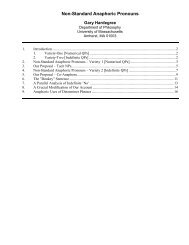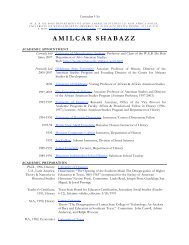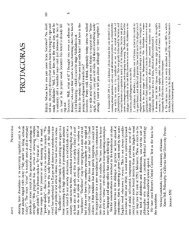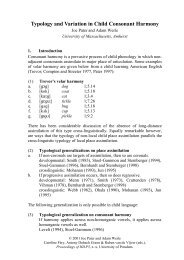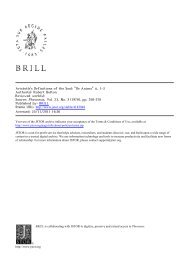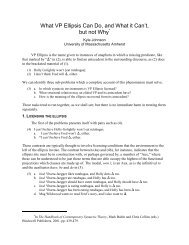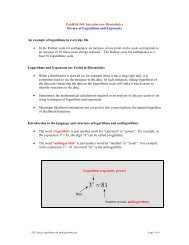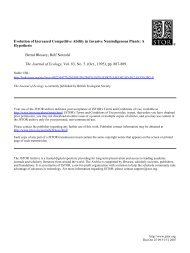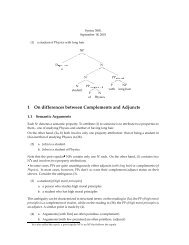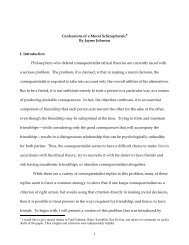The Psychology of Bystanders, Perpetrators, and Heroic Helpers
The Psychology of Bystanders, Perpetrators, and Heroic Helpers
The Psychology of Bystanders, Perpetrators, and Heroic Helpers
You also want an ePaper? Increase the reach of your titles
YUMPU automatically turns print PDFs into web optimized ePapers that Google loves.
<strong>The</strong> Origins <strong>of</strong> Genocide <strong>and</strong> Collective Violence<br />
genocide (Kuper, 1981). In mass killing, the boundaries <strong>of</strong> the victim group<br />
are less well defined, <strong>and</strong> the elimination <strong>of</strong> a whole racial, religious, or ethnic<br />
group is not intended. For example, in Argentina the victims included<br />
Communists, people seen as left leaning, <strong>and</strong> liberals who wanted to help<br />
the poor or supported social change. Usually, although not always, mass<br />
killings have fewer victims. <strong>The</strong> Holocaust, the killings <strong>of</strong> the Armenians,<br />
<strong>and</strong> the killings in Rw<strong>and</strong>a were genocides; the killings in Cambodia were<br />
genocidal but with less well defined group boundaries, in that Khmer as<br />
well as members <strong>of</strong> minority groups were killed; the disappearances in<br />
Argentina were a mass killing. Genocides <strong>and</strong> mass killings have similar<br />
psychological <strong>and</strong> cultural origins.<br />
This chapter will focus on the psychology <strong>and</strong> role <strong>of</strong> both perpetrators<br />
<strong>and</strong> byst<strong>and</strong>ers. <strong>Byst<strong>and</strong>ers</strong> to the ongoing, usually progressively increasing<br />
mistreatment <strong>of</strong> a group <strong>of</strong> people have great potential power to<br />
influence events. However, whether individuals, groups, or nations, they<br />
frequently remain passive. This allows perpetrators to see their destructive<br />
actions as acceptable <strong>and</strong> even right. As a result <strong>of</strong> their passivity in<br />
the face <strong>of</strong> others' suffering, byst<strong>and</strong>ers change: <strong>The</strong>y come to accept the<br />
persecution <strong>and</strong> suffering <strong>of</strong> victims, <strong>and</strong> some even join the perpetrators<br />
(Staub, 1989a, 1989b, 1999a, 2oooa,b).<br />
All <strong>of</strong> us are byst<strong>and</strong>ers to many events - neither actors nor victims but<br />
witnesses. We witness discrimination <strong>and</strong> the fate <strong>of</strong> the homeless. We have<br />
known about torture in many countries, the death squads in Guatemala<br />
<strong>and</strong> El Salvador, the use <strong>of</strong> chemical weapons by Iraq to kill its own Kurdish<br />
citizens while our government <strong>and</strong> many others supported Iraq, the imprisonment<br />
<strong>of</strong> dissidents in mental hospitals in the Soviet Union (Bloch&<br />
Reddaway, 1977,1984)~ <strong>and</strong> the nuclear policies <strong>of</strong> the United States <strong>and</strong><br />
the USSR. Examination <strong>of</strong> the role <strong>of</strong> byst<strong>and</strong>ers in genocides <strong>and</strong> mass<br />
killings may enlighten us about our own role as byst<strong>and</strong>ers to others' suffering,<br />
<strong>and</strong> to policies <strong>and</strong> practices that potentially lead to the destruction<br />
<strong>of</strong> human beings.<br />
Another focus <strong>of</strong> this chapter is the psychology <strong>of</strong> those who attempt to<br />
save intended victims, endangering their own lives to do so. <strong>Byst<strong>and</strong>ers</strong>,<br />
perpetrators, <strong>and</strong> heroic helpers face similar conditions <strong>and</strong> may be part<br />
<strong>of</strong> the same culture: What are the differences in their characteristics, psychological<br />
processes, <strong>and</strong> evolution?<br />
BRIEF REVIEW<br />
A conception is presented in this chapter <strong>of</strong> the origins <strong>of</strong> genocide <strong>and</strong><br />
mass killing, with a focus on how a group <strong>of</strong> people turns against another<br />
group, how the motivation for killing evolves <strong>and</strong> inhibitions against it<br />
decline. <strong>The</strong> conception identifies characteristics <strong>of</strong> a group's culture that<br />
create an enhanced potential for a group turning against others. It focuses



